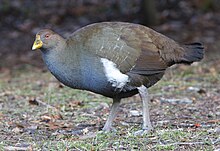Tribonyx mortierii
| Tasmanian nativehen | |
|---|---|
 |
|
| Tasmanian nativehen at Mt Field National Park | |
| Scientific classification | |
| Kingdom: | Animalia |
| Phylum: | Chordata |
| Class: | Aves |
| Order: | Gruiformes |
| Family: | Rallidae |
| Genus: | Tribonyx |
| Species: | T. mortierii |
| Binomial name | |
|
Tribonyx mortierii du Bus de Gisignies, 1840 |
|
 |
|
| Tasmanian native hen distribution | |
| Synonyms | |
|
Gallinula mortierii |
|
Gallinula mortierii
The Tasmanian nativehen (also Tasmanian native-hen or Tasmanian native hen) (Tribonyx mortierii) is a flightless rail and one of twelve species of birds endemic to the Australian island of Tasmania. Although many flightless birds have a history of extinction at the hands of humans, the Tasmanian nativehen has actually benefited from the introduction of European-style agricultural practices in Tasmania.
Other common names include narkie, waterhen and turbo chook. This species was originally described in 1840 as Tribonyx mortierii. The name mortierii is in honour of Barthélemy Charles Joseph Dumortier.
The Tasmanian nativehen is a stocky flightless bird between 43 and 51 centimetres (17 and 20 in) in length. The upperparts are olive brown with a white patch on the flank. The underparts are darker with a bluish grey tinge. The short tail is close to black and mostly held erect. The legs are thick and powerful, with a grey scaly appearance and sharp claws. The eyes are bright red. The bill has a small frontal shield and is a greenish yellow colour.
The juvenile bird is similar in appearance to the adult, but the colours are more subdued on the body and the underparts have fine white spots. The bill is greenish yellow and the eyes are bright red. Male birds generally have longer bills and legs, though there is enough overlap that the sexes are indistinguishable, even in the hand.
The Tasmanian nativehen is a sedentary species, living around open grassy areas close to water. It is widespread in Tasmania apart from the west and south west regions. It is not found on King or Flinders Islands in Bass Strait, though Michael Sharland does record it as being on Flinders Island. A population introduced to Maria Island is now well established. It is generally common and easily seen around bodies of water that have grassy verges.
Fossil records indicate that the Tasmanian nativehen was found on the Australian mainland until around 4700 years ago. Suggested reasons for its extinction there have included the introduction of the dingo, or an extremely dry period.
...
Wikipedia

